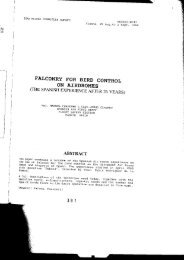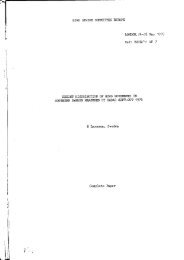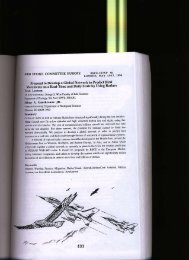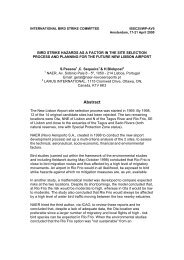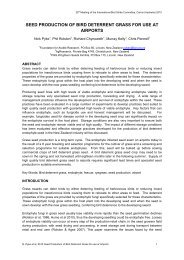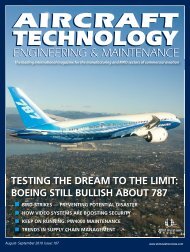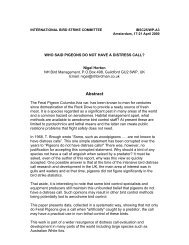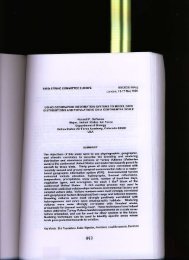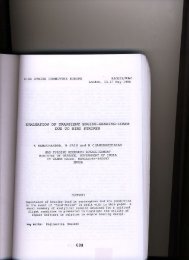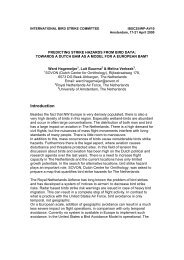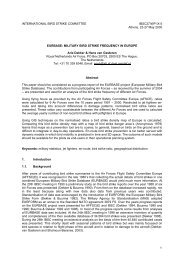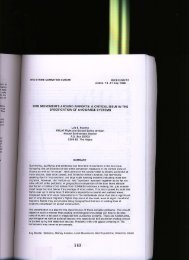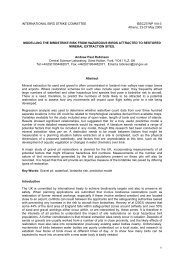Standards for aerodrome bird/wildlife control - International Bird ...
Standards for aerodrome bird/wildlife control - International Bird ...
Standards for aerodrome bird/wildlife control - International Bird ...
You also want an ePaper? Increase the reach of your titles
YUMPU automatically turns print PDFs into web optimized ePapers that Google loves.
INTRODUCTION<br />
Several excellent handbooks exist that describe in detail the techniques that can be<br />
used to manage the <strong>bird</strong>/<strong>wildlife</strong> strike risk on <strong>aerodrome</strong>s (e.g. ACI 2005, CAA 1998,<br />
Cleary & Dolbeer 1999, Transport Canada 2001). There has, however, been little<br />
attempt to determine the levels of investment in time, manpower, equipment, training<br />
and monitoring that are needed to effectively manage the <strong>bird</strong>/<strong>wildlife</strong> hazard. This<br />
contrasts with other <strong>aerodrome</strong> safety provisions, such as levels of fire <strong>control</strong><br />
equipment and manpower, that are precisely defined by regulation. This situation has<br />
arisen, in part, because the levels of risk, the habitat type, and the <strong>bird</strong>/<strong>wildlife</strong><br />
species present at different <strong>aerodrome</strong>s varies, and the precise techniques that are<br />
successful at one site may not work at another. It is also partly due to differences in<br />
the levels of resources available at different airports and to differences in the attitude<br />
of airport managers and national regulators to the risk posed by <strong>bird</strong>/<strong>wildlife</strong> strikes.<br />
The new <strong>International</strong> Civil Aviation Organisation <strong>Standards</strong> And Recommended<br />
Practices (SARPS) on airport <strong>bird</strong>/<strong>wildlife</strong> <strong>control</strong> became effective in November<br />
2003. The guidance material accompanying the SARPS is in the process of being<br />
updated. This guidance will, when combined with the various manuals listed above,<br />
provide the technical detail needed to construct a <strong>bird</strong>/<strong>wildlife</strong> <strong>control</strong> programme. It<br />
does not, however, describe the levels of ef<strong>for</strong>t that are needed if a <strong>bird</strong> <strong>control</strong><br />
programme is to operate effectively. It was there<strong>for</strong>e agreed at the 26 th meeting of<br />
IBSC in Warsaw that a set of IBSC standards should be developed by the committee<br />
to address this issue.<br />
This paper seeks to identify those areas where universally applicable practices can<br />
be identified, and suggests levels of airfield habitat management, <strong>bird</strong> <strong>control</strong><br />
equipment, manpower, etc. that, in the opinion of the IBSC membership, an airport<br />
should have in place if it is to effectively manage the <strong>bird</strong>strike risk to aircraft. It is<br />
envisaged that these standards will in<strong>for</strong>m airport managers, national regulators, the<br />
insurance industry, lawyers etc. about what they should expect to see invested in<br />
<strong>bird</strong>/<strong>wildlife</strong> <strong>control</strong> at an airport. Airports with unusually high <strong>bird</strong>/<strong>wildlife</strong> strike risk <strong>for</strong><br />
whatever reason would be expected to invest more in strike prevention than is<br />
described below in order to reduce that risk.<br />
There are clearly many private <strong>aerodrome</strong>s that are too small to justify the provision<br />
of <strong>bird</strong>/<strong>wildlife</strong> <strong>control</strong> to the levels described in this document. However, in the<br />
opinion of IBSC, these standards should apply to any <strong>aerodrome</strong> carrying<br />
regularly scheduled commercial air traffic, irrespective of the movement<br />
frequency or type of aircraft involved.<br />
No attempt has been made to provide a detailed scientific underpinning <strong>for</strong> the best<br />
practices proposed. Those wishing to explore the underlying science in more depth<br />
are referred to previous volumes of the proceedings of IBSC ( www.int-<strong>bird</strong>strike.com<br />
), <strong>Bird</strong>strike Committee Europe, <strong>Bird</strong>strike Committee N. America (www.<strong>bird</strong>strike.org<br />
and www.<strong>bird</strong>strikecanada.com), German <strong>Bird</strong>strike Committee ( www.davvl.de ),<br />
and the scientific literature. The aim of this document is to distill collective experience<br />
of ornithological and aviation experts into a set of basic standards that the aviation<br />
industry as a whole can use.<br />
6



